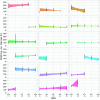Everyday language input and production in 1,001 children from six continents
- PMID: 38085754
- PMCID: PMC10756310
- DOI: 10.1073/pnas.2300671120
Everyday language input and production in 1,001 children from six continents
Abstract
Language is a universal human ability, acquired readily by young children, who otherwise struggle with many basics of survival. And yet, language ability is variable across individuals. Naturalistic and experimental observations suggest that children's linguistic skills vary with factors like socioeconomic status and children's gender. But which factors really influence children's day-to-day language use? Here, we leverage speech technology in a big-data approach to report on a unique cross-cultural and diverse data set: >2,500 d-long, child-centered audio-recordings of 1,001 2- to 48-mo-olds from 12 countries spanning six continents across urban, farmer-forager, and subsistence-farming contexts. As expected, age and language-relevant clinical risks and diagnoses predicted how much speech (and speech-like vocalization) children produced. Critically, so too did adult talk in children's environments: Children who heard more talk from adults produced more speech. In contrast to previous conclusions based on more limited sampling methods and a different set of language proxies, socioeconomic status (operationalized as maternal education) was not significantly associated with children's productions over the first 4 y of life, and neither were gender or multilingualism. These findings from large-scale naturalistic data advance our understanding of which factors are robust predictors of variability in the speech behaviors of young learners in a wide range of everyday contexts.
Keywords: human diversity; infancy; language; socioeconomic status; speech.
Conflict of interest statement
Competing interests statement:The authors declare no competing interest.
Figures





References
-
- Pinker S., The Language Instinct (Morrow, New York, NY, 1994).
-
- R. Coe, It’s the effect size, stupid (2002). https://f.hubspotusercontent30.net/hubfs/5191137/attachments/ebe/ESguide.... Accessed 28 July 2021.
MeSH terms
Grants and funding
LinkOut - more resources
Full Text Sources
Research Materials

